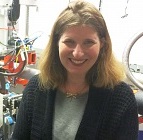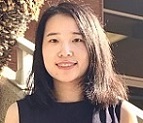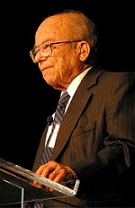Vol. 20, No. 3 - September-October 2019
View the Archives

Science Highlight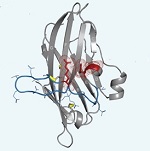 Structure and Functional Binding Epitopes of V-domain Ig Suppressor of T-Cell Activation (VISTA) – Contacts: Jennifer R. Cochran and Nishant Mehta, Stanford University Implicated in human cancers including skin, prostate, colon, pancreatic, ovarian, endometrial, and lung, the protein called VISTA (V-domain Ig Suppressor of T-cell Activation) indirectly promotes cancer growth by interfering with T-cell function. In mouse models, antibodies against VISTA show anti-cancer activity, and are being developed by multiple pharmaceutical companies for evaluation in clinical trials. It is sometimes seen to function as a receptor and sometimes as a ligand. A team of scientists has undertaken structural studies to better understand the function of the VISTA protein. Read more... Meeting Summary2019 SSRL/LCLS Users' Meeting and Workshops 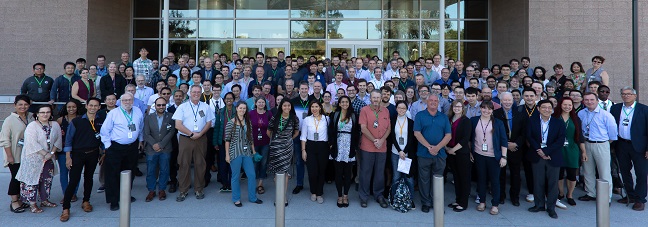 Our joint SSRL/LCLS Annual Users’ Meeting attracted over 350 people who participated in a diverse program over 4 days that included 13 focused workshops, a full day plenary session, over 90 poster presentations, a town hall discussion, SSRL and LCLS UEC meetings as well as meet-and-greet sessions. Several awards were presented:
The 2019 Joe Wong Outstanding Poster Awards were presented to:
These poster awards are made possible by support from longtime SSRL user, Joe Wong, Ph.D., D.Sc., Fellow of the American Physical Society, and are given to the most exciting, novel, and compelling science as presented during the poster session. Thank you to everyone who organized or joined in the activities. While this event is fresh in your mind, we encourage your feedback and suggestions for our next joint SSRL/LCLS Users’ Meeting which is being planned for September 30–October 2, 2020. SSRL Users' Executive Committee UpdateUEC Election Results Election results for SSRL's Users' Executive Committee (UEC) are in. Please join us in supporting Timothy Stemmler (Wayne State University) as the new SSRL UEC Chair and Eddie Snell (Hauptman Woodward Research Institute) as SSRL UEC Vice-Chair. We thank everyone who agreed to be nominated and extend a warm welcome to newly elected members: Angelia Seyfferth (University of Delaware), Rebecca Page (University of Arizona), and re-elected member Blaine Mooers (University of Oklahoma Health Sciences Center). For the coming year, we would like to acknowledge the continuing contributions of Graham George (University of Saskatchewan) who rotates from SSRL Chair to Past Chair, David Bushnell (AtomiX Labs Inc) who continues in his role of Past Chair, and the entire SSRL UEC for their continued support of SSRL. Our thanks also to retiring committee members David Barondeau (Texas A&M University) and Marco Keiluweit (University of Massachusetts). Honors and AwardsAina Cohen Receives 2019 Farrel W. Lytle Award Excerpt from October 1, 2019 SLAC News Article by Bobbi Fagone
Aina Cohen, co-leader of the Structural Molecular Biology Division at SSRL, is the latest recipient of the Farrel W. Lytle Award. This award celebrates achievements in synchrotron-based science and efforts to foster collaboration to make the best use of experimental time for both staff and visiting scientists at SSRL. Cohen is being honored for many impressive achievements over the last two decades. Perhaps two of her most innovative accomplishments working with her colleagues and team members at SSRL are to fully automate the macromolecular crystallography experiment including the implementation of a robotic sample exchange system and to develop the world’s first fully remote accessible structural biology beamlines. “Using keen management skills and her science and engineering background, Aina runs a myriad of projects and support staff, all with the goal of providing the best facilities possible for the research community,” says staff scientist and SMB colleague Jennifer Wierman. “Keeping SSRL at the forefront of x-ray macromolecular crystallography, Aina routinely spearheads collaborations and innovations crucial to our vision of excellence.” Read more... Xinru Wang Wins 2019 Klein Award for Research on Cell Signaling in Enzymes Excerpt from September 10, 2019 SLAC News Article by Ali Sundermier
Xinru Wang received the 2019 Melvin P. Klein Scientific Development Award for her research on cell signaling in enzymes. She accepted the award at the SSRL/LCLS Annual Users’ Meeting and gave a talk about her research during the afternoon plenary session on Thursday, September 26. The Klein award recognizes outstanding research accomplishments by undergraduates, graduate students and postdocs within three years of receiving their PhD who used SSRL for their research. Established in 2006 by the SSRL Users’ Executive Committee, the award honors the late Melvin P. Klein, a biophysicist and pioneer in the field of spectroscopic methods, including x-ray absorption spectroscopy. Wang’s research explores a small class of enzymes called serine/threonine phosphatases that play a crucial role in cell function. Her focus is on a process called dephosphorylation in which a phosphate group is taken away by the enzyme, either activating or deactivating a cellular event. She is specifically interested in how these enzymes identify their substrates – the molecules on which they act to produce chemical reactions – and how these chemical modifications change their ability to interact with other proteins. Read more... 2019 American Physical Society Fellows Announced Excerpt from APS Press Release
The American Physical Society (APS) has elected the Society's 2019 Fellows. The APS Fellowship Program recognizes members who have made exceptional contributions to the physics enterprise in physics research, important applications of physics, leadership in or service to physics, or significant contributions to physics education. Donghui Lu, co-leader of SSRL's Materials Sciences Division, with citation “For seminal contributions to the development of synchrotron-based angle-resolved photoemission spectroscopy and the resultant understanding of quantum materials, especially iron and copper based superconductors.”
Michael Toney, co-leader of SSRL's Materials Sciences Division, with citation “For many contributions to the development of in situ synchrotron x-ray scattering and spectroscopy methods for studies of organic materials, photovoltaics, and electrochemical interfaces related to energy materials systems. lightsources.org NewsFormer SSRL Staff Joins BESSY Scientific Management Team Jan Luening, former SSRL staff scientist and professor at Pierre und Marie-Curie University, was recently appointed as the Scientific Director for the Matter department at the Helmholtz-Zentrum Berlin fur Materialien und Energie. See announcements by HZB and lightsources.org. AnnouncementsCall for 2020 Panofsky Fellowship Applications – Deadline November 15, 2019 The Panofsky Fellowship honors SLAC National Accelerator Laboratory’s founder and first Director, Wolfgang K. H. Panofsky. It is intended to recognize exceptional and promising young scientists who would most benefit from the unique opportunity to conduct their research at SLAC National Accelerator Laboratory. Candidates should be early in their career but have demonstrated experience at the postdoctoral level with clear potential for exceptional scholarship, breadth, innovation, and leadership. The candidate's research plan should encompass one or more areas within the general scope of the science program at SLAC:
For more information, please consult the Panofsky Fellowship page. Events
User Research AdministrationBeam Time Requests
Proposal Deadlines
Submit beam time requests and proposals through the User Portal. _____________________________________________________________________ The Stanford Synchrotron Radiation Lightsource (SSRL) is a third-generation light source producing extremely bright x-rays for basic and applied research. SSRL attracts and supports scientists from around the world who use its state-of-the-art capabilities to make discoveries that benefit society. SSRL, a U.S. DOE Office of Science national user facility, is a Directorate of SLAC National Accelerator Laboratory, operated by Stanford University for the U.S. Department of Energy Office of Science. The SSRL Structural Molecular Biology Program is supported by the DOE Office of Biological and Environmental Research, and by the National Institutes of Health, National Institute of General Medical Sciences. For more information about SSRL science, operations and schedules, visit http://www-ssrl.slac.stanford.edu. To unsubscribe from SSRL Headlines, just send an e-mail to listserv@slac.stanford.edu with "signoff ssrl-headlines" in the body. To subscribe, send an e-mail to listserv@slac.stanford.edu with "subscribe ssrl-headlines" in the body. Questions? Comments? Contact Lisa Dunn
|

